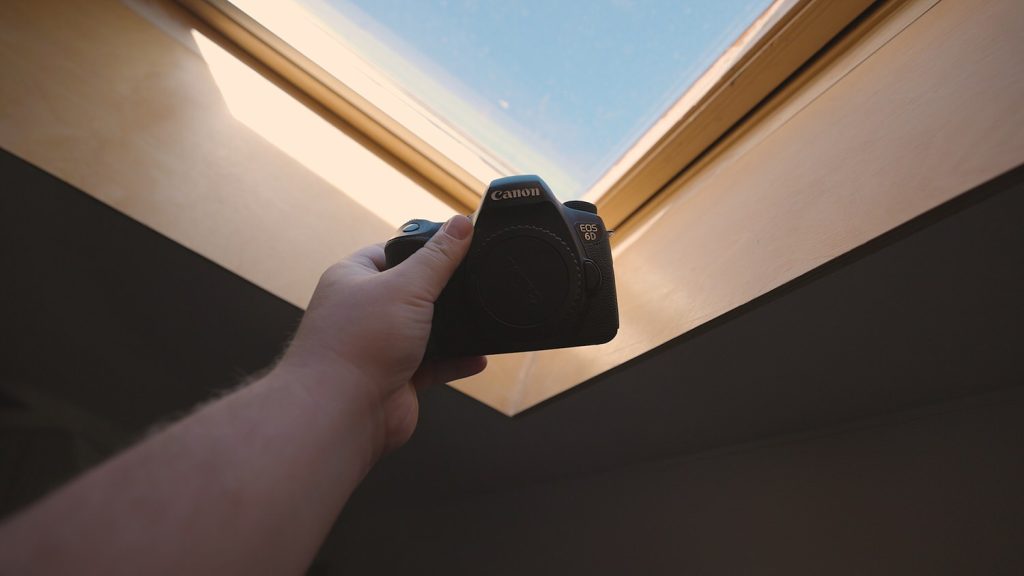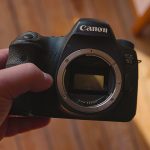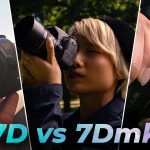In this article, we’re going to compare two somewhat different cameras, the Canon 6D, and the Canon 77D, also known as the Canon EOS 9000D in Japan, and the Canon EOS 770D in Mainland China.
Let’s begin.

Size & Build
First off, let’s have a look at the size and build quality of each camera. The Canon 6D measures 144mm x 110.5mm x 74.8mm, and weighs in at around 765 grams.
The Canon 77D on the other hand measures 131mm x 99.9mm x 76.2mm, and weighs in at around 540 grams.
So, right off the bat, we can tell that the Canon 6D is physically larger than the 77D. This can be a good or a bad thing, depending on what you prefer.
I personally like beefier cameras, so as far as I’m concerned, the 6D is nicer, at least from a size perspective.
In terms of build quality, both are equivalent. Both devices are made from a combination of an aluminium alloy frame, and a coating of polycarbonate resin. I really like the look and feel of Canon cameras, as they all feel nice to hold in the hand.

Image Quality
Next up, let’s discuss image quality. I’m going to show you some photos I’ve taken with both cameras, but first, let’s discuss the components that make up the image quality.
Sensor
The Canon 77D has a 24.2 MP 22.3mm x 14.9mm APS-C sensor, whilst the Canon 6D has a 20.2 MP 35.8mm x 23.8mm Full Frame CMOS sensor. Despite the fact that the 6D is 5 years older than the 77D, the 6D does have a larger sensor, which will allow in more light.
Does that mean that it automatically produces better-quality images?
Well, let’s explore further.

Processor
In terms of processors, the Canon 77D has the DIGIC 7, whilst the 6D has the DIGIC 5+. This isn’t surprising, given the age difference between these two cameras.
When the DIGIC 5 processor initially came out, it brought better noise reduction, and better white balance. The problem is that obviously, the DIGIC 7 has those things, with a few additions.
The DIGIC 6 brought 1080p @ 60fps, which the 77D can no, but the 6D can not. The 6D can only do 1080p @ 30fps. If you absolutely want to do 60fps on the 6D, you’ll have to step down to 720p.
What about the actual DIGIC 7, the one that the 77D has? This generation brought higher-resolution images, better subject tracking, and image stabilisation.
Image Stabilisation
Speaking of image stabilisation, do either of these cameras have it?
Well, the 77D does, but it’s digital. Unfortunately, any kind of in-camera digital image stabilisation is generally useless. If you enable it, it will crop the image somewhat, in order to stabilise, thus you will lose image quality.
Not only that, but this will be burnt into the video file, so you won’t have access to the shakier original. Given that digital stabilisation is always advancing, you’re better off just recording shakier footage, and then stabilising it in Premiere Pro, or whichever editing software you use.
If you absolutely want some optical stabilisation, or more specifically, stabilisation that happens physically, and not digitally, you’ll either have to get a way more expensive camera, for in-body image stabilisation, or get a lens with IS in the name.
If you’re just looking for a far better camera, with in-body stabilisation, check out my reviews of the Canon R, and R5 on my YouTube channel.
If you want a lens with IS, you can also check out my review of the Canon EF-S 18-55mm lens, on my YouTube channel.

Autofocus
Speaking of processors, how well can these cameras autofocus?
Unsurprisingly, the 77D dominates with up to 45 cross-type AF points, whilst the 6D struggles with 11 AF points. In simple terms, when using autofocus, the 6D will struggle a lot more than the 77D.
Also, the 77D has the legendary Canon Dual Pixel AF, whilst the 6D does not, as the technology wasn’t out when the camera was released.
ISO
What about ISO?
The 77D can do 100-25600, expandable to 51200. The 6D can do 100-25600, but you can expand it to be able to do 50-102400.
ISO is basically just a way to increase the brightness of your image, at the cost of introducing unwanted noise, or grain. Ideally, you’ll want to know how to juggle aperture and shutter speed, only really touching ISO as a last resort, when limited by the other two.
Also, the upper ranges of the ISO on either camera would practically be useless, due to the large amount of unwanted noise that you will have in your images. In most scenarios, you’ll be under 400 ISO, maybe around 800 in the evening.
Shutter Speed
What about if you want to freeze motion?
Well, the shutter speed can go up to 1/4000s of a second, which is more than enough to freeze most action. If you want to use continuous shooting mode, you’ll be able to do 6 frames per second.
In other words, say you’re looking to photograph wildlife or sports. In continuous shooting mode, you’ll capture 6 different photos in one second, thus increasing the odds that you capture the exact right moment.
Now that we’ve covered image quality, let’s have a look at some of the photos I’ve taken with both cameras.
Video
Next up, video. Which one of them is better for video?
Honestly, the 77D beats the 6D hands down. Even though the B-roll of the 6D has been filmed on my Canon R5, the B-roll for the 77D has actually been filmed on a second 77D.
If you know what you’re doing, you can actually get some great video with the 77D. The extra AF points, and the Dual Pixel AF make filming a lot easier, and the fact that it can do 1080p @ 60fps puts it well ahead of the much older 6D.
With that in mind, what if you’re looking to actually learn video?
In that case, I might actually recommend the 6D, instead of the 77D. Allow me to explain.

Why?
You see, the 6D is technologically more limited, as it is 5 years older than the 77D, so it has fewer features, and it’s harder to use.
If you want to learn photography and videography, that’s precisely what you need. If your camera is really good, and can do things by itself, you’ll have no reason to try and learn how to do things yourself.
Why bother learning about manual focus, when the camera can just read your mind, and focus instantaneously? I mean, why learn how to expose your photos correctly, when the camera nails it nine times out of ten?
Why learn to balance aperture, shutter speed, and ISO, if you get perfect, clean images each time?
Now, I’m not saying that the 77D will do all those things, but I am saying that it’s better at them, compared to the 6D. As a result, the 77D might actually make you a bit lazy.
If you buy the older camera, all of its technical limitations will force you to get creative, and this is the best way to learn a new skill, especially photography and videography.
Vlogging
Ok, so what about vlogging? Can either of these cameras do it?
In the case of the 77D absolutely, but in the case of the 6D, kind of.
One of the most important components of a vlogging camera is the articulated screen. In other words, can you flip the screen, so you can see what you’re doing?
The Canon 77D has that, but the 6D does not. On the 6D, the screen is fixed. This gives a clear advantage to the 77D in this regard.
YouTubers
What if you want to film online content? Well, you can mount either of these cameras on a tripod, and get decent results. If you’re just filming yourself talking, you don’t need 60fps.
In fact, all you need is 1080p @ 24fps, which either of these cameras can do. You can even get a Canon EF 50mm f1.4, or f1.8, and achieve that really nice blurred-out background.
The reason why the 77D still has the advantage in this case, is because it has more AF points, and Dual Pixel AF. Especially if you’ll be filming yourself at f1.4, or even f1.8, the 6D autofocus capability might come short, compared to what the 77D can do.

Compatible Lenses
Now, what about compatible lenses? Which can these cameras use?
Well, the Canon 77D can use both EF, and EF-S lenses, which make up the majority of Canon lenses. With this camera, you’ll have access to decades of lenses that you can choose from.
What about the 6D?
The 6D can actually only use EF lenses exclusively, which limits you a little bit, especially if you’d like to buy some of the more affordable lenses in the Canon range.
Display
What about displays?
As covered previously, the 77D has a flippable screen, which is also touch-sensitive, whilst the 6D has a fixed screen, which does not respond to touch.
Additionally, both cameras have top LCD displays, which allow you to quickly and easily see your settings.
Some photographers don’t like these, but I personally think they look beautiful. My only real complaint when it comes to my Canon R5, is that the top LCD isn’t large enough. It just looks kind of squished.
Control
How easy are these cameras to control?
If you’ve used a Canon camera before, you’ll be super familiar with the layout of both of these. You have a few buttons on the back, which allow you to go through menus and such, and you also have a few on the top, right next to the top LCD screens.
Storage
Do either of these cameras have dual SD card slots?
Nope, both have only one card slot. The reason why you might want two is in case you’re doing professional gigs. Obviously, you can do professional gigs with whichever camera you like, but there is always the small risk of an SD card becoming corrupt.
If this happens with one of the cards, you have a backup. If not, you’re out of luck.
It is important to note that I’ve never had an SD card become corrupted, but it is always a possibility.

Battery Life
What about battery life?
The Canon 6D uses the LP-E6 battery, which is also used on the 5D Mark III, 5D Mark II, and the 7D. This battery, if new, should allow for about 1000 photos before running out of juice.
The Canon 77D on the other hand uses the LP-E17 battery, which should provide you with about 600 shots. As a rule of thumb, you should always carry more than one battery, so you don’t risk missing any good shots.
Longevity
When it comes to longevity, both these cameras are rated for approximately 100,000 actuations. What does this mean?
Whenever you take a photo, a mechanical process takes place inside the camera. As a result, there is only so many times that this mechanical process can happen, before it becomes unreliable, or it completely breaks down.
In this case, this means that you can take around 100,000 photos with these cameras, before the shutter, theoretically, fails.
Given that you’re likely to purchase these cameras second-hand, it’s recommended that you ask the seller how many photos the camera has already taken.
If they say that they don’t know, or won’t tell you, it’s best to move on, as that probably means the number is high. The number of actuations will obviously affect the price of the camera.
Conclusion
In conclusion, which camera should you purchase? The Canon 6D, or the 77D?
This one’s a bit tough. If you absolutely want a full-frame sensor, at a lower price, the 6D would be a great choice. It’ll allow you to take beautiful photos, even though you’ll be limited in terms of video and lens choice.
If you want to do more video stuff, you’re better off with the 77D, due to the fact that it can do 1080p @ 60fps, and because it has the Dual Pixel AF, with the 45 cross-type AF points.
As mentioned earlier, if you want to learn a lot about photography and videography, you might actually be better off with the 6D. Due to its limitations, you’ll be forced to creatively solve problems, and thus learn in a manner which is far more effective than reading about something, or watching a video.
By the way, I’ve reviewed both of these cameras individually, so if you want to check that out, you can watch them on my YouTube channel or you can read them on this website.
Which?
If you’ve already learnt a bit about photography and videography, and you’d like to graduate to something more mid-range, feel free to have a look at the camera review playlists on my YouTube channel.
I’ve reviewed all sorts of cameras, from the Canon 77D and 7D MkII, to the Canon R, and Canon R5.
If you’d like to purchase any of the items I’ve mentioned in this article, or see how much they cost in your country, I have a link down below where you can view them.
Thank you for reading my comparison review of the Canon 6D vs Canon 77D. I invite you to have a look at some of my other articles. We have something for everyone, whether you’re interested in audio, or cameras and lenses. Alternatively, if you prefer video reviews, feel free to have a look at my YouTube channel.
Product Links
Down below you will find all of the items I talked about in this article.



